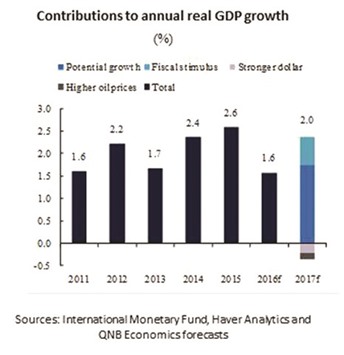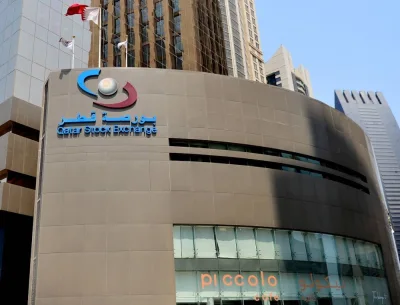The US economic growth is expected to accelerate to 2%, around the average of recent years, QNB said in an economic commentary.
This is mainly due to the expected fiscal stimulus from the new Trump administration, notwithstanding the drag from a stronger US dollar and higher oil prices.
The stimulus, QNB said, is likely to be enough to reduce unemployment further and push inflation higher, prompting the Fed to raise rates twice next year.
In terms of growth rates, the performance of the US economy in 2016 was mediocre. Growth is expected to have been 1.6%, below what most economists consider as potential (1.75%) and below the average rate since 2011 (2%).
But by other accounts, the economy has not done so badly. Unemployment fell to 4.7% — below its long-run equilibrium — and inflation is progressively moving up towards its 2% target. As a result, the economy is entering 2017 operating at near capacity. Furthermore, the prospects of a fiscal stimulus by the new Trump administration means that, for the first time since the 2008 crisis, the economy faces the risk of over-heating and running above its productive capacity.
What will happen to the US economy in 2017? And how will the Fed respond? QNB expects growth to be slightly above potential at 2%; and the Fed to continue its tightening cycle by raising rates twice next year.
Three factors are expected to shape the US growth outlook in 2017.
First, Trump’s fiscal stimulus package is forecast to provide a boost to the economy. While there is uncertainty about the size, timing and composition of the stimulus, we assume a package consisting of income and corporate tax cuts as well as increased spending on infrastructure and other items. Overall, QNB expects this stimulus to contribute 0.6 percentage points (pps) to GDP in 2017.
Second, the rise in the US dollar is expected to offset some of the impact of Trump’s stimulus package. The US dollar has appreciated significantly following Trump’s victory in the presidential elections as financial markets foresaw a larger divergence in monetary policy between the US and other advanced economies.
QNB expects the US dollar to appreciate further in 2017, which will reduce the competitiveness of US exports. As a result, QNB projects net exports to lower growth by around 0.2pps in 2017.
Third, higher oil prices are expected be a drag on growth. QNB expects oil prices to rise from an average of $45 a barrel in 2016 to $55. This could help oil and gas investments, which have declined by nearly 5% in the first three quarters of 2016 compared to a year earlier.
But this would also hurt consumption as higher oil prices reduce the income available to consumers to spend on other items. Since consumption accounts for a much larger share of GDP than oil and gas investments (70% versus 1%), the net impact of higher oil prices is expected to be negative on growth by around 0.2pps.
Collectively, the three factors (fiscal policy, US dollar and oil prices) provide a cyclical boost to GDP of around 0.3%. Adding this to potential growth (the growth rate determined by the growth in the labour force plus productivity gains, estimated to be around 1.75%), yields a 2% growth forecast for 2017.
How is the Fed expected to respond to the improved growth outlook next year? In its latest projections, the Fed projects three rate hikes in 2017. However, we think that macroeconomic conditions warrant only two.
The 2% growth is expected to reduce the unemployment rate by 0.2% to 4.5% by end-2017. In addition, core inflation is expected to rise by 0.1% to 1.8% over the same period.
Using the Fed’s standard rule linking interest rate decisions to inflation and unemployment (the so-called Taylor Rule) the magnitude of improvement in economic conditions suggest two rather than three rate hikes. This is in line with financial markets, which are currently pricing in two rate hikes next year.

.


